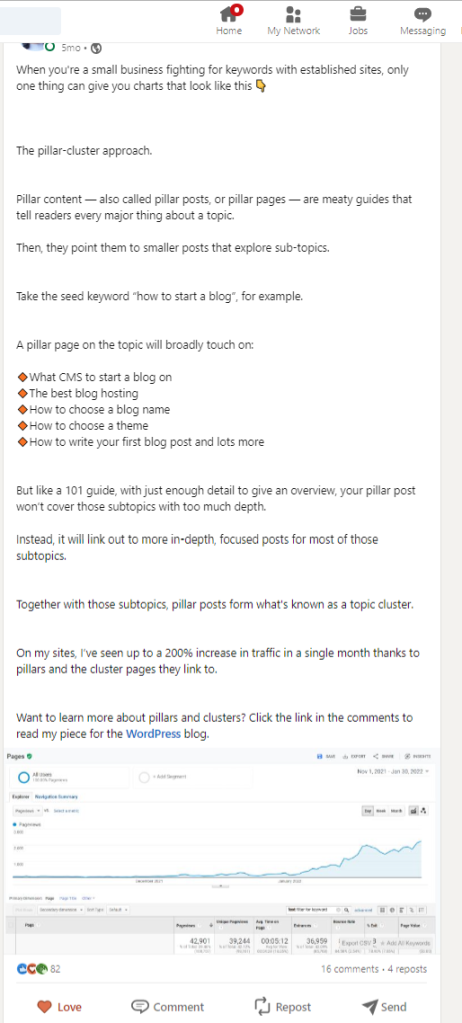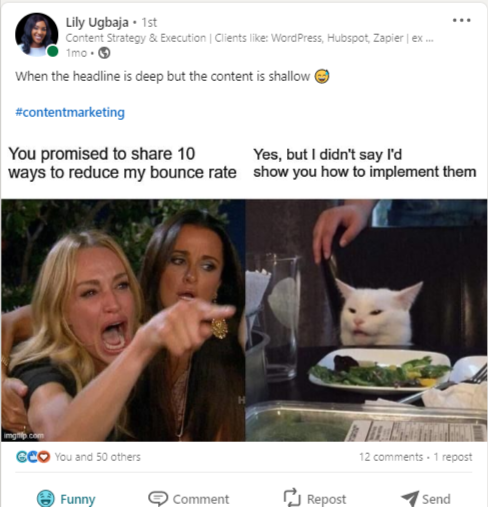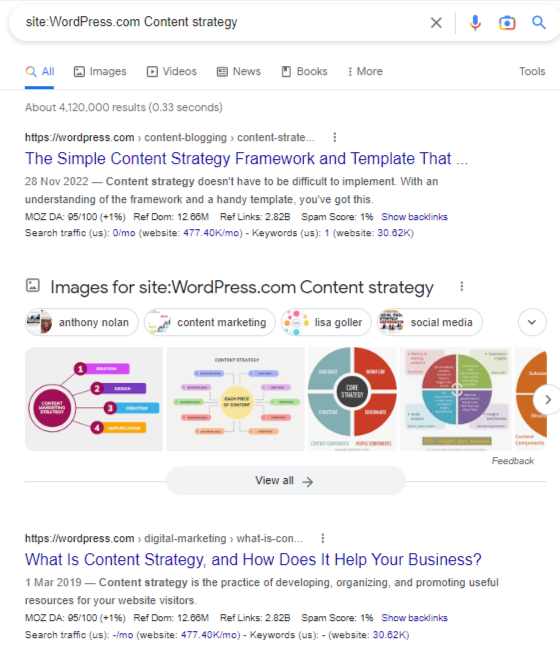I know how it feels.
The anxiety that comes from seeing so many days open in your work calendar, you don’t know for sure that you’ll cover next month’s bills.
Low-paying clients who demand an arm and a leg — despite their unfair pay — become a necessary evil. And you start rethinking your choice to leave the 9 – 5.
Like you, many freelancers struggle to get clients. In fact, more than half of freelancers (56%) say getting clients is their biggest challenge.
4 years ago, landing clients was my biggest challenge too. But today, I’m a freelancer who charges rates in the top 10% of my industry, works with considerate clients who respect me, and hasn’t had a dry run in 2+ years.
This article outlines what changed for me and what most freelancers who never run out of work know.
In this article:
- Why clients buy from vendors
- Get in front of potential clients (the ‘know’ factor)
- Become your values (the ‘like’ factor)
- Exceptional delivery + social proof (the ‘trust’ factor)
- Now it’s time to find clients
Why clients buy from vendors
If you’ve applied to freelance jobs you’ve found on job boards, or LinkedIn, you know that finding job listings is the easiest part.
To get clients to hire you, that’s where things get hard. Especially since there’ll be hundreds of other freelancers gunning for the same gig.
The more “know, like, and trust” signals you send, the more likely you are to win the gig.
“All things being equal, people do business with, and refer business to people they know, like and trust.” – Bob Burg, Author of Endless Referrals.
Think about it. If you wanted to hire a baker for your daughter’s 1st birthday, which one of these profiles would you choose?
| Profile A New baker on the block. They have no samples but promise that they make good cakes. You don’t know them and can’t find any references for past work. | Profile B Talented baker. People praise their cakes everywhere. But rumor has it that they’re difficult to work with. They even canceled last minute on the couple down the street. | Profile C Baker who made the cake everyone kept praising at your niece’s birthday. They live down your street, are extremely friendly, and your sister says they could easily be friends. |
My money’s on profile C.
- You know them from a referral or the ads in front of their shop.
- You like them because people say they’re nice, they say hi to you when you pass them on the street, or maybe they have a cute daughter around your child’s age!
- You trust that they’ll meet your expectations because you’ve seen them do it before, and neighbors rate them highly too.
Let’s talk about things you can do to get known, liked, and trusted. So you, too, can increase your chances of being hired.
Get in front of potential clients (the ‘know’ factor)
Remember when I said I haven’t had a dry run in 2+ years? Well, it gets even better. All my clients find me themselves and ask me to work with them!
I owe that to being visible where they hang out, so the minute they need someone with my expertise, I’m the first person to come to mind.
Here’s what I’ve done:
Set up a website or online portfolio
When clients find you on social media or directories, they might search for you online.
Having a website or online portfolio:
- Gives clients the opportunity to research your work and references and — therefore — gain full confidence before they engage with you.
- Enhances your discoverability through keywords on platforms such as Google. I can’t count the number of time people said they found me on Google when they were searching for a “B2B SaaS Marketer”.
It’s also just more professional 🤷
You can create your website with the WordPress.com website builder. Here are the steps:
1. Look at other websites for inspiration
Analyzing the websites of fellow freelance service providers in your niche or industry shows you:
- How to structure your website
- Design elements to include
- How to frame your services in a manner that convinces potential clients and highlights your uniqueness
- The pages to include in your website.
That way, you can create a mental picture of what your website should look like.
You could Google your service keyword to find the top providers on Google or search on social media.
2. Create a website account
Once you have an idea of what your website should look like, choose a website hosting platform (we use WordPress.com), and do this:
- Create an account. This usually just involves filling out a very short form.
- Choose a domain name. This will serve as your website’s address online. With WordPress.com, you can either use the free domain with a WordPress.com extension. Or select any of the premium domains, and we’ll cover the costs for one year (on our paid plans only). You could also use a domain you already own.

Tip! Choose a domain name that’s short and includes an industry-related keyword.
For example, the ideal domain name for a freelance photographer called Ben would be: Benphotography.com.
It’s short and includes the name of his industry (photography).
3. Select a website theme
The theme determines the appearance of your website.
WordPress.com has a huge library of themes you can choose from to customize your website. Some are free, while others are paid. Ensure the theme you choose has the features you need —- portfolio page, contact page, etc.

All WordPress.com themes are responsive by default, but if you don’t use WordPress.com make sure you select a theme that adapts to different screen sizes. This way, visitors will have a positive experience on any device they use to access your website.
4. Design and launch your website
The last step is to design your website and launch it.
At the very least, your website should have:
Clear homepage copy
Your homepage is the first place your client lands on when they visit your page. So, you should use it to grab attention, explain what you offer over others, and convince the client you’re the right person for the job.
Highlight your unique value proposition (UVP) — what differentiates you from others? Do you have a unique process? Or is there an additional value you offer that others don’t? Spell it out in clear terms.
Here’s a snippet from Rebecca Hey’s website: She says what she does immediately. And she follows it up with her UVP, “our clients see a 600% growth in traffic in just 12 months — with zero ad spend”.

Confidence-inducing, high-quality images
Pixelated images tell potential clients that you’re still struggling, and almost everyone wants to work with the biggest star, not the wannabe.
I noticed a tremendous difference in client perception when the photos on my website went from this:

…to this:

The same goes for your portfolio images as well. When you include images that showcase your work (like this graph that shows the effects of my content strategy services), pay attention to their quality as well.

A portfolio or examples of your work
A well-presented and updated portfolio serves as proof of your expertise and experience.
Rather than just listing work examples, you could explain the results, thought processes, and unique skills used to arrive at the final product using a mini-case study. This further highlights your expertise.
I also noticed more people reach out once I started to include results in my portfolio.
An About Me page that stands out
An about me page tells the client who you are, what you do, and the reason you do it. This creates a personal connection with your potential clients, which builds trust and credibility.
You can use these 30 examples of about me pages as inspiration.
A Contact page with an easy-to-use form
The contact page gives clients ways to reach you. And the contact form ensures clients leave behind details you can use to contact them.
Your contact page should, at the very least, contain your name and the mediums client can use to reach you (email, a call, email, social media handles, etc.).
While the contact form must have fields for the client’s name, email address, and a brief description of their challenge.
Tip! You can use WordPress.com’s beginner-friendly contact form, available in all WordPress.com plans.
READ MORE: You can check out our detailed guide on building a website.
Establish a social media presence
Social is the second most popular medium (after search engines) where people research products or services before they buy.
80% of my clients find me from my social media profile while searching for content marketers to hire. Or after reading any of my posts.
To maximize the potential of social media, do the following:
Be on the networks where potential clients are active
Trying to be active on every social media platform is tiring. And leaves little time to focus on client work and developing your craft.
Instead, focus on being where potential clients are.
Of the 80% of clients who find me on social media, for example, I’d approximate 95% find me on LinkedIn.
So how do you know the platforms used by your clients?
One way is through the nature of your service. LinkedIn and Twitter are often perfect for business clients (i.e., businesses selling to other people).
But if you sell to consumers (B2C), Facebook and Instagram may be better choices for you.
Also, a graphic artist is more likely to find potential clients if they’re on visual-heavy platforms like Instagram and TikTok.
Another way is to look to other experienced freelancers in your niche. There is a good chance your clients use the same platforms they do.
Post consistently
Social media algorithms reward consistency. They prioritize accounts that post consistently and promote their content to more people.
Diane Kelly Levey says being consistent on LinkedIn has gotten her clients over the years. Her posts get featured in the feeds of potential clients.
According to her, “when I’ve reached out to editors and former colleagues, they’ve often said they enjoy reading my posts and articles. Plus I’ve gotten thousands of dollars of work from recent connections on LinkedIn who’ve read my posts and articles in the past few months”.
Additionally, Ryan Scollon, an independent PPC consultant, agrees being consistent is beneficial.
“I try to be consistent on social media by posting at least once a week,” he says.
“Doesn’t seem much. But it keeps my name out there in front of people’s faces. After each post, I always get one or two messages from old contacts who either need my services or know someone who does”.
This experience from Ryan helps redefine consistency.
It’s not posting every day. It’s simply choosing a posting cadence and sticking to it.
It could be twice a week. Daily. Or even once a week.
Be yourself
People interact with content that’s personal just as much as they interact with professional advice.
- Talk about a setback.
- Post a meme you loved.
- Or lessons from a movie you watched.
That way, you’re never stuck on what to post.
For example, here’s a more “professional” post I made promoting my post about topic clusters. Notice the engagement on it?

Now compare it with this funny meme I shared. The engagement is almost the same. This means people will engage with your post, even if it’s not some professional advice. Just be you.

Interact with other professionals in your field
It’s called SOCIAL media for a reason. You’re supposed to be social: engaging with the posts of others with thoughtful comments, responding to comments on posts, and answering messages.
Occasionally, you could go a step further to message people who engage with your posts. Or message fellow professionals to congratulate them on a recent accomplishment.
I’ve gotten clients just by messaging people who engage with my posts. Here’s one example:

Get listed on freelance directory sites that are relevant to the work you do
Freelance directory sites are online databases that match freelance service providers with potential clients.
Getting listed in these directories increases your visibility and attracts potential clients.
Some examples include Thebriefcollective, Freelancermap, Guru, Superpath, and Unicorn factory.
There are generalist and specialist directories.
The generalist directories cater to freelancers of every industry, niche, and skill. A great example is Guru.
On the other hand, specialist directories only accept freelancers within a specific industry. An example is Superpath, which accepts only freelance writers.
There are two ways to find these directories:
Perform a web search
Combine the name of your industry together with the keyword freelance directory.
A photographer, for example, will search using “photographer freelance directories” or “freelance directories for photographers’. This reveals a ton of directories.
Asking fellow freelancers.
You can ask freelancers in your industry for the directories they use or to recommend one.
Be active in online communities where potential clients are
Potential clients sometimes use online communities to find solutions to problems they face.
Answering their queries demonstrates your expertise, making you the first person they think of hiring.
According to Rebecca Hey, “I’ve had prospects reach out to me at the suggestion of a friend or colleague because I answered a question asked in a Facebook community, I felt qualified to answer.”
These communities exist on platforms like:
- Quora
- Slack
Ask other freelance service providers what communities they belong to.
Share your knowledge
Be open to sharing tips, lessons from something you read, or a recent mistake you learned from.
Someone who benefits from it may hire or refer work to you in the future.
Ask and answer questions
Don’t be afraid to ask questions or answer questions. It makes you an engaged member of the community and displays your expertise.
Per Ryan Scollon’s experience, “there are plenty of marketing and business related groups on social media where my ideal clients are asking questions. All I do is answer questions as best as I can, and it often leads to the person (and others) dropping me a direct message to work together”.
But always strive to give accurate answers. Because one wrong answer can damage your reputation.
Go to events
Events are an opportunity to connect directly with decision-makers at businesses and other prospects. I’m signing a contract with a decision-maker I met at an event this month.
You don’t regularly meet these decision-makers, and your cold email may be part of the 91.5 percent they ignore.
To find events:
Use event finder platforms
Use platforms like Eventbrite, Stubhub, and 10times to find physical events close to you. Filter the events by distance and industry.
Pay attention to leaders in your space
Follow industry leaders in your niche. Take note of the events they’re attending.
Ask around
Some events are invite-only. To get them, ask fellow freelancers about the networking events they’re attending. You can also let them know you’re interested in attending events, so they can keep you in the loop.
Write guest articles on other companies’ or freelancers’ blogs
The first client I ever got came from a guest post. In fact, I wasn’t even looking for clients, I was a blogger just promoting my blog, and that was my 2nd guest post ever.
Guest posting helps you leverage the audience of established brands to get in front of clients.
It also helps you demonstrate expertise in your field and build relationships with other professionals.
The first step is to find blogs in need of guest posts. You can do so using:
Google search operators
You can use these search operators:
- “[your keyword]” +”write for us”
- “[your keyword]” +”write for me”
- “[your keyword]” + “guest post”
- “[your keyword]” +”contribute”
- “[your keyword]” +”submit a guest post”
- “[your keyword]” + inurl:write-for-us
Keep in mind that these publications will have lots of submissions, and your work can easily drown. Focus on writing for publications with extremely high standards for submissions.
Before you send out your pitch, take your time to read other articles on the blog and guest posting guidelines (if any).
Pay close attention to the type of topics covered on the blog, their tone, and other rules outlined in the guideline.
Use this search operator to know if the topic you’re pitching is already on the blog:
Site: (website) (keyword)
Say you’re pitching an article titled “building sales strategy for your early stage product” to WordPress.com. You would run a search with the search operator below:
Site: WordPress.com sales strategy.

This reveals all the articles on the WordPress.com blog about content strategy so you can pitch something with a different angle.
Speak at events
You can use speaking opportunities to showcase your expertise and value to potential clients and build your visibility. This month, I got 6 leads from speaking at just one podcast.
To find these events:
- Ask your network
- Send cold pitches to National Organizations in your niche
- Pitch events freelancers in your niche have spoken at
Before you pitch to speak at an event, select a topic that you are well-versed in. That way, you’d speak with confidence and use personal experiences to back up your claims. And the audience will perceive you as an expert.
Dmytro Sokhach, the founder of Admix Global, suggests a framework called EDU (Expertise, Demand, and Underrepresentation) for crafting a well-received pitch.
- Expertise: Demonstrate real-life experience on the topic
- Demand: show people are looking for the solution
- Underrepresentation: Show the proposed topic is underrepresented in industry guides, blogs, and courses.
Become your values (the ‘like’ factor)
You can’t be liked by everyone. This is the truth.
But if you place your values left, right, front, and center on your social profiles and website, you attract people who’ll naturally like you — and there are more than enough of them!
Humanize yourself, represent your values
Talk about your kids, your fight with cancer, your VR headset, or whatever you feel comfortable sharing from your personal life.
If there’s something you feel strongly about, talk about it often. You’ll draw people who relate to your personal struggles and wins.
Exceptional delivery + social proof (the ‘trust’ factor)
Referrals are an essential part of being a freelancer. In fact, 54 percent of freelancers agree referrals are important to be successful freelancers.
Additionally, a recent report by Mailchimp shows more than 37% of freelancers receive work from client referrals.
But clients and colleagues can’t refer others to you if you don’t do enough to earn their trust. Neither will clients send more work your way.
So, how do you become someone that people trust?
Be someone people can count on (and let word of mouth do its work)
Clients who refer you risk their reputation whenever they do so. Because if you fail to deliver, it could damage their reputation and relationship with the person they referred you to.
So, they always want to be sure they’re providing a quality recommendation. They can’t refer you if you always under-deliver.
Here’s how to be someone people can count on:
- Don’t misrepresent your skills
- Keep organized so you can keep your commitments
- Overcommunicate so no one’s left in the dark
Add testimonials and quotes from customers to your site
While researching for this piece, I interviewed several people who hire freelancers. They all cited testimonials and quotes from former clients as major factors in choosing freelancers.
And that’s expected since they demonstrate your expertise and show you’ve achieved similar results for other clients.
However, not every client will want to share a testimonial. So, how do you make them more likely to say yes when you ask?
Make it easy
Sometimes, a client may find it hard to come up with what to write as a testimonial. So, make it easy.
For example, Ryan Scollon uses a 4-question request:
- What was it like before me?
- What made you happiest about working with me?
- What made me stand out from others?
- What have you been able to achieve since using my service?
This way, they simply answer each question, which you can turn into a testimonial.
Reference the value you provided
This means citing the value you gave in your request for a testimonial helps the client remember your work and makes them more likely to provide you with one.
Offer something in return
Alli Hill suggests offering something in return when soliciting referrals. You could offer to drop them a positive review on Google or other review sites. Or a backlink on your website.
Ask your best customers for referrals to their friends and colleagues
Clients don’t mind giving referrals when you have a great relationship with them.
So how can you request referrals?
Ask immediately if they acknowledge you delivered an excellent job
Once you provide excellent service, ask your clients if they know anyone who may benefit from your services.
You can frame it this way:
I’m looking to expand my client base and was wondering if you know anyone who may be in need of my services.
Follow up after you’ve requested
After requesting a referral, thank them for their help. Then let them know what steps you took to contact their referrals.
Now it’s time to find clients
Your chances of attracting and retaining clients will increase once you implement tips that boost your visibility, make clients trust you, and increase your likeability.
Most likely, your biggest stream of inbound clients will come from word-of-mouth referrals. But you still need to set the ball rolling at first.
In our selling services online guide, we go deeper into strategies for differentiating your positioning and finding clients to pitch on service-specific platforms.

